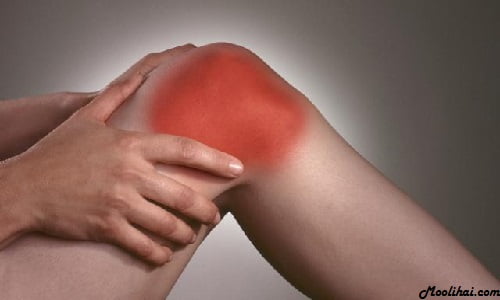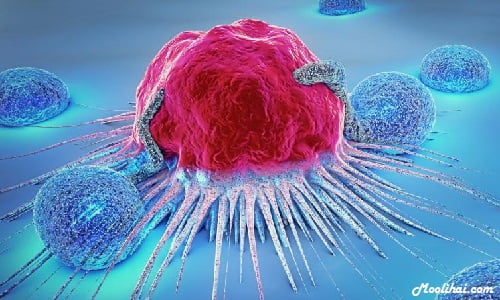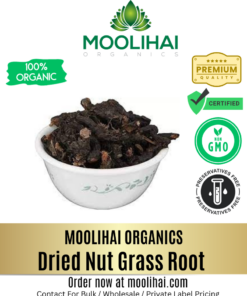Info
Benefits Of Nut Grass (Musta Or Cyperus Rotundus)
Cyperus Rotundus is a perennial herbaceous plant that is closely related to the botanical families Cyperus Esculentus and Chufa. This herbaceous plant is native to southern Europe, Central Europe, France, Africa, South Asia, and Austria.
Known by various names such as Nut Grass, Red Nut Sedge, Purple Nut Sedge, Java Grass, Coco Grass, Khmer Kravanh Chruk, and Musta, Cyperus Rotundus is one of the most invasive plants in the world.
The botanical name of this Nut grass plant is derived from the Greek word κύπερος> kyperos> rotundus (Latin = “round“). This perennial plant can grow up to 140 cm in height. Growing mostly in arid lands (barren lands and crop fields), these plants have the characteristics of growing in moist soil.
The leaves of the nut grass plant, like other Cypress plants, are 2 to 8 inches long at the base. Its glossy dark green leaves, which form from the base of the plant, have three tiers of leaf blades.
The stems of the flowers are triangular, bisexual, and have a triangular pistil with a triangular cross-sectional appearance. The inflorescence has 3 to 8 unequal spikes. The most rarely produced fruit on this plant has a three-pronged axis.
This perennial, herbaceous, colonial plant is widely propagated by its tubers and rhizomes. Its young plants produce colored fleshy rhizomes up to 25 mm in size. The main product of this plant is its rhizomes which can grow in any direction (top, bottom, horizontal) in the soil.
Some plants that grow in arid areas form tubers that grow upwards in the soil, forming a bulb-like structure and then forming new roots and shoots from them. New rhizomes will start to grow from the new roots thus formed and this production will continue.
Other plants produce rhizomes that grow downward or horizontally, forming dark reddish-brown tubers. That is, downward-growing tubers form individual tubers or chains of tubers. These rhizomes are more succulent and fibrous as they grow.
A mature tuber is dark reddish-brown in color, about 10-35 mm long and 12 mm thick.
Its tubers have a bitter taste but have various nutritional values and medicinal properties. In famine-stricken areas, these tubers are often stapled food.
In all the traditional medicines around the world, it has been confirmed that the parts of the Nut Cross plant are used to make medicines to cure diseases.
They are used to improve the function of the nervous system and cure stomach ailments and also act as a diuretic. Besides, the roots of this plant are used as perfume in India.
History Of Cyperus Rotundus / Nut Grass

Cypress Rotundus, a perennial plant that originated in Southeast Asia, is proved by researchers to have spread to various parts of the world about 2000 years ago. Various parts of this medicinal plant have been used as food, medicine, and perfume for centuries by ancient peoples living in the Nile Valley, Africa, the eastern Mediterranean, and China.
There is evidence that Pliocene hominins ate a portion of this starchy tuberous plant as a staple food. And C. Rotundus has been the staple food of indigenous peoples living in Central Australia during the Renaissance.
In 500 AD, references to these species of plants were first found in a Chinese medicine book (Nekpi, 1992). Microbial and biomarkers of the Cyperus Rotundus plant have been found in the human dental calculus of the Meroitic pre-Islamic Kingdom (300–400 AD) on display at the Al Khiday archaeological complex in central Sudan.
Nut Grass contributed to a relatively low frequency of tooth decay and their ability to effectively prevent mutants. This is the reason Nut Grass consumption was so high among Al Khiday Meroitic people.
Cyperus Rotundus was used as an excellent water purifier and perfume in ancient Mycenaean Greece, Egypt, and various parts of the world. Renowned ancient Greek physicians Pliny the Elder, Theophrastus, and Dioscorides considered Cyperus Rotundus to be the best medicine and recommended its use.
Evidence suggests that the Nut Grass plant was accidentally introduced to the United States in the 1800s and is still cultivated and used by people living in the West Indies to this day.
Energetics
- Rasa (taste): Tikta (bitter), Kashaya (astringent), Katu (pungent)
- Virya (action): Sheeta (cooling)
- Guna (qualities): Rooksha (dry), Laghu (light)
- Dosha (constitution): Balances Pitta and Kapha doshas
- Vipaka (post-digestive effects): Katu (converts to pungent after digestion)
Common Names of Nut Grass
- English Name: Brown nut sedge, Nut sedge, Coco-grass, Purple nut sedge, Nut-grass, Java Grass, Red nut sedge, Galingale, chaguan humatag, Purple flat sedge, Nut grass, purple nutsedge, nutgrass, purple nut-grass, ground almond, Water Grass, red nut sedge
- Tamil Name: Korai-Kizhangu, Korai
- Malayalam Name: Kuzhimuthanga, Karimuttan, Muthanga
- Telugu Name: Tungamustalu
- Kannada Name: Konnari Gadde
- Hindi Name: gantola, Deela, nagar motha, korai
- Marathi Name: Nagarmoth, Moth, Bimbal, Motha
- Gujarathi Name: Nagarmoth, Moth
- Bengali Name: Musta, Mutha
- Punjabi Name: Motha, Mutha
- Urdu Name: Sad Kufi
- Sanskrit Name: Krodeshta, Mustaka, Varida, Hima, Raja Kaseruka, Megha, Ambhoda, Abda
15+ Health Benefits of Nut Grass

All parts of the nut grass plant have various medicinal properties. Its roots have been widely used in Indian Ayurvedic medicine and traditional Chinese medicine for thousands of years. Rated for its high medicinal properties, this plant is used to prevent many diseases and to treat their effects. Medicinal uses of Purple nut sedge can be found here.
1. Helps Manage Blood Sugar

One of the leading causes of metabolic disorders is high blood sugar, also known as diabetes, which can cause changes in various functions of the body. Nut Grass has been shown to be effective in the diet of diabetics.
The extract derived from this plant helps to inhibit the enzymes (α-glucosidase and α-amylase) that cause the body’s rapid carbohydrate digestion. One of its rhizomes helps to prevent the frequent increase in blood sugar in diabetics, and Nut Grass has the ability to turn this rhizome into an antihyperglycemic agent.
A study conducted on animals with high blood sugar, they were subjected to a hyperglycemic test. In which those animals were given Purple nut sedge extract as a medicine. At the end of the study, it was revealed that the blood sugar level of the animals was significantly lower due to the antioxidant activity of the plant.
32 studies have shown that the antioxidant properties of Purple nut sedge extracts are entirely due to their abundant antioxidants.
Also Read: Best Herbs for Diabetes
2. Handles Blood Pressure Level

Nut grass plants, also known as musta, have significant hemodynamic properties. This hemodynamic property greatly aids in inducing impaired respiration and improving blood flow.
Furthermore, the results of some studies conducted on this Nut Grass confirmed its hypotensive effect. More so, studies have shown that alcoholic extract derived from Purple nut sedge has the property of controlling blood pressure and gradually lowering it.
Therefore, regular intake of this extract can cause changes in blood pressure and give a better effect. Nut Grass juice has long been recommended and used in various traditional medicines as one of the best medicines to manage high blood pressure.
Also Read: Best Herbal Remedies For Blood Pressure
3. Treats Digestive Ailments

According to ancient Ayurveda, the chemical components in Purple nut sedge cure indigestion by increasing digestive fire. The Musta plant is an excellent remedy for combating indigestion and also helps to rejuvenate the digestive system.
In addition to the chemical components, this plant contains various active compounds and enzymes that contribute to improve the digestive system and stimulate biochemical reactions.
In Asian folk medicine, nut rhizomes are widely used to treat various stomach problems such as irritable bowel syndrome, diarrhea, intestinal disorders, abdominal pain, indigestion, and intestinal parasites.
These are recommended as the best natural medicine for other digestive problems like nausea, vomiting, flatulence, colon disorders.
Studies in animals on the effects of Purple nut sedge have shown that they help reduce the severity of vomiting. Severe diarrhea can be controlled by consuming decoction made by boiling Nut Grass powder in water.
Honey is mixed with its powder to treat diarrhea in young children (as recommended by an Ayurvedic practitioner). The researchers said that the Nut Grass plant had an antihypertensive activity that controlled the toxic production of Escherichia coli, which causes diarrhea.
Also Read: Best Herbs Naturally Boost Digestion
4. Limits Epileptic Seizures

Cyperus Rotundus has sedative and antispasmodic effects on the body. Animal and test-tube studies show that the extract from its roots relaxes the muscles of the body and has a calming effect on the nerves.
Nut Grass is used in traditional Ayurvedic medicine to treat epileptic seizures. In a study on nut grass extract, evidence proved that they effectively carry out the anticonvulsant functions of animals.
In addition, these were found to greatly reduce the duration of the seizure and its severity. The main reason for the antiepileptic effect carried out by these plant juices is their unique antioxidant properties.
The rats were given ethanol extract of nut grass to control leptazol and strychnine induced epilepsy. At the end of the study, it was revealed that the seizure was effectively controlled.
Researchers say that this ethanol extract, controls epilepsy, contains flavonoids, which greatly promote anticonvulsant activity. Recent research suggests that this extract may be used to make medicines for the treatment of epilepsy.
5. Possesses Anti-inflammatory Traits

The alcoholic extract of Purple nut sedge helps to protect the body from inflammatory processes by fighting against induced edema and carrageenan.
Oedema is known as dropsy, is the medical term for water retention in the body. And Carrageenan is an indigestible polysaccharide extracted from red algae that usually acts as a thickening or stabilizing agent.
Nut Grass extract was given to albino mice, which have been shown to act for formaldehyde-induced arthritis and significantly reduce the dose of impact. The petroleum ether extract is separated from the rhizomes of the nut grass plant.
A chemical compound called Triterpenoid is extracted from this extract using a laboratory separation method called Chromatographic. Studies also show that the triterpenoid compound in petroleum ether extract has powerful anti-inflammatory properties.
Nut grass extract is used as a medicine to treat all inflammatory diseases.
Also Read: Best Spices & Herbs For Inflammation
6. Anti-Spastic & Anti-Diarrheal Potential

Nut grass has the ability to exert considerable relaxation action on smooth muscles. Ethanol extract obtained from this plant is known to have the property of creating relaxation in the ileum, the third part of the small intestine.
In the study of rabbits with chemically induced wrinkles, they were given Nut Grass juice for 45 consecutive days. In conclusion, it was revealed that this extract produced a spasmolytic effect against the contractions of rabbits.
Nut grass has been used in Ayurvedic medicine to control chronic and acute diarrhea. The study was performed on rats to confirm its antidiarrheal effect. In this study, rats were first given castor oil to induce diarrhea, followed by Purple nut sedge extract as a medicine. These reduce the risk of diarrhea in mice by about 46%, the researchers said.
Also Read: Natural Home Remedies for Diarrhea
7. Has Cancer-Fighting Properties

Nut Grass, one of the drugs used to treat body ailments, regulates the function of body organs and protects the body from the dangers of infection, handles safe methods that do not cause side effects in humans.
Since Cyperus Rotundus has the strength to fight early-stage cancer it is believed that these may protect you in the fight against cancer. Researchers have found that the extract from the rhizome of this plant has anticancer activity in fighting a variety of cancer-causing cells.
Otherwise, the study revealed that it does not affect non-cancer normal cells in any way.
Also Read: Best Herbs to Treat Cancer
8. Acts As a Galactagogue

The roots of the Nut Grass plant are used to improve the quality and purification of breast milk, which means that the decoction made from its roots is very beneficial for the milk secretion of young mothers.
You can increase the amount of breast milk by gently grinding the fresh tubers of this plant and applying the paste on the breast. Not only Ayurveda but also ancient medical methods recommend the use of Nut Grass plants to improve their lactation in all young mothers.
The characteristics of Cyperus Rotundus have recently been tested in young mother rats. In it, Nut Grass juice was given daily to the mother rats, which demonstrated a significant increase in the amount of milk secreted by the rats after certain days.
Mice consuming Nut Grass juice were found to have increased carb and tissue content compared to normal mice. In another study like this, the weight of mammals consuming Nut Grass juice increased significantly, and this juice did not cause any toxic side effects.
9. Controls Obesity & Fat Levels

Nut Grass plays an important role in reducing obesity by removing excess Kapha, fat, and triglycerides from the body. The Nut Grass root extract was given to the overweight mice daily for 3 consecutive months.
It was revealed that this juice stimulated the breakdown of fats in order to expel the fat deposited in the tissues of the rats and thus effectively reduced the body weight of the rats. Although the extract of this plant does not reduce the intake of food, it has a significant effect on the weight loss process.
These are considered to be the best and natural weight loss medication as they stimulate the breakdown of fat without causing any side effects on the body.
Obese people were given two Nut Grass capsules per day (made from 450 mg of Purple nut sedge tuber juice) for 3 consecutive months. At the end of the study, it’s proven that participants’ body weight, cholesterol, and triglyceride levels were lower.
In another study, participants were given 3 g of Nut Grass tuber powder (mixed with water) three times a day for 3 months. There was a significant decrease in their waist circumference ratio, and Body Mass Index (BMI).
Musta plants greatly help to reduce subcutaneous fat deposits, fatigue, excessive hunger, and thirst. Cyperus Rotundus is a major contributor to the expelling of toxins and heavy metals found in human fat cells today.
Nut Grass extract contains ascorbic acid and polyphenols, which help prevent the oxidative stress caused by obesity. As a result, metabolic disorders such as diabetes and heart disease are prevented.
Also Read: Natural Herbs & Spices To Lower Cholesterol
10. Eases Conjunctivitis Symptoms

Conjunctivitis or pink eye is a term used to describe an inflammatory condition of the eye that causes itching in the eye. Conjunctivitis causes redness of the eyes and continuous tearing.
As I have already stated that nut grass has anti-inflammatory properties so it is advisable to use them in these conditions. It has been found in human experimental subjects that the nut grass extract can be used externally to treat various types of eye problems including conjunctivitis.
11. Effectively Treats UTI (Urinary Tract Infections)

Nut Grass effectively controls the growth and impact of pathogens in the urinary tract, making it an effective remedy for urinary tract infections. Studies show that they help prevent infections by stopping the growth of free radicals in our bodies.
In ancient times, the Cyperus Rotundus was considered as a powerful medicinal plant and added within the daily diet, and they still hold a special place in folk medicine today.
Its rhizome has diuretic properties, so ingesting tuber powder with food will stimulate more urine excretion. Toxins in the body can be easily excreted due to excessive urine excretion.
Also Read: Best Herbs to Cure Urinary Problems
12. Treats Rheumatoid Arthritis & Osteoarthritis

Nut Grass greatly contributes to the proper functioning of the body organs. That is, the anti-rheumatic and anti-inflammatory properties of this plant allow the body to better manage its condition.
In addition, Ashwagandha also has high anti-inflammatory properties, so combining the Nut Grass plant with Ashwagandha can have some serious protective effects on the body.
The extracts of these two herbs were mixed in equal proportions and made into capsules, which were given to rheumatism patients three times a day for 3 consecutive months. At the end of the study, the drug significantly reduced the severity of rheumatic symptoms and the resulting pain.
This Nut Grass plant extract relieves rheumatism and also acts as an excellent pain reliever. Its extract can be used to treat both arthritis and rheumatoid arthritis, according to medical studies.
13. Fights Aging & Counters Dementia
 Effective in treating major diseases like high blood pressure, cancer, Parkinson’s disease, Alzheimer’s due to the high antioxidants in nut grass. It also has a free radical-scavenging property that fights free radicals to strengthen the body’s immune system.
Effective in treating major diseases like high blood pressure, cancer, Parkinson’s disease, Alzheimer’s due to the high antioxidants in nut grass. It also has a free radical-scavenging property that fights free radicals to strengthen the body’s immune system.
This can easily reduce the appearance of premature aging skin and skin-related neurotransmission. A study of animals in relation to nut grass found that it helps to cope with learning disabilities and contributes greatly to improving cognitive problems.
14. Alleviates Menstrual Problems

The Nut Grass plant is considered to be the best choice for treating problems like the irregular menstrual cycle, lack of menstruation, and excessive bleeding. And this medicinal plant contributes in the best way to stimulate the menstrual flow at the right time.
Furthermore, studies show that these herbs provide additional benefits when combined with some other serious medicinal plants that treat menstrual problems. Recent studies on these plants have shown that the Cyperus Rotundus plant is quick to treat anemia.
Also, when ingested the juice or powder of the Nut Grass plant internally it gives strength to the body to overcome the general weakness caused by the menstrual disorder.
15. Helps Good Skin & Hair

The paste obtained by grinding nut grass root well is used to treat skin diseases like scabies, eczema, itching, psoriasis, fungal infections, and herpes. Nut Grass is very helpful in brightening the skin tone by controlling the excessive production of skin pigment called melanin.
Extrapone is a compound found in the extract of the base of the nut grass, which is an important ingredient used in most beauty products for whitening the skin.
Despite the lack of research evidence, the juice and powder of the nut grass plant help prevent the appearance of premature aging by keeping the skin fresh.
The oil made from this plant is considered to be the best natural alternative for laser hair removal treatments. This is because they effectively remove unwanted dark print hairs, white molds, and light molds.
In one study, participants were recommended to apply Nut Grass oil on the scalp at a rate of 0.25 ml per day for approximately 6 months. In conclusion, it was demonstrated that it promoted the hair growth of the participants and various hair problems were remedied.
Cyperus Rotundus is a natural way to treat hair and skin related problems without any side effects.
Also Read: Best Herbs for Skin
Also Read: Best Natural Herbs for Hair Growth
16. Protects the liver

Nut Grass greatly contributes to improving liver function and protects them from various impacts. In a study of mice with induced liver damage, they were given the ethyl acetate extract of Nut Grass.
In conclusion, this extract has been shown to cure liver disorders and have significant protective effects. Nut Grass significantly reduces serum levels of enzymes such as glutamic pyruvic transaminase, glutamic oxaloacetic transaminase, alkaline phosphatase, and bilirubin, thus having protective effects on the liver.
Also Read: Effective Herbs For Healthy Liver Function
17. Aids Fast Wound Healing

A paste made by grinding the roots of the Cyperus Rotundus plant is used as a wound-healing ointment. These improve the tensile strength of the wound site and reduce pain by speeding up the wound healing process.
Studies show that they help prevent cancer by stopping the growth of free radicals in our bodies. In addition, the ointment reduces inflammation, tissue fluid leakage, and tissue inflammation.






Ponnatharam Stone (Raw) | For Permanent Hair Removal
Vengai Paal | Black Bindi | Dhrishti Pottu | Vengai Pottu for Babies | 100% Natural
Dried Avaram Senna Flower / Cassia Senna Auriculata / Aavaram Poo / Tarwar / Amaltas Leaves / Senna Auriculata / Avaram Poo / Sanay / Alexandrina / Tanner’s Cassia flower
Akasa Garudan Kilangu / Redfruit Creeper / Corallocarpus Epigaeus
Natural Dried Moringa Flower – Moringa Oleifera – Drumstick Tree Flower – Murungai Poo – Munagaku Flower
Original Edible Camphor | Pacha Karpooram | Bhimseni Camphor
Saussurea Obvallata Seeds / Brahmakamal Seeds / Queen of the night / Sacred Saussurea Kon Kapfu / Brahma Kamalam / Nishagandha
Insulin Leaf Powder / Chamaecostus Cuspidatus / Costus Pictus / Spiral Ginger / Insulin Powder / Costus Igneus
Achu Pottu for Babies | Bindi Mould Set | Baby Seratta – 1 Set
Kaunch Beej Powder |Poonaikali | Velvet Bean Powder | Mucuna Pruriens | Kapikacchu | Natural Nervine Tonic & Muscle Builder
Aalam Pazham / Banyan Fruit Powder / Ficus Benghalensis / Marri Palu / Bargad / Dodda Alada Mara / Peraal / Vat Vriksha Powder
Traditional Vasambu Valayal for Babies | Calamus Bracelet | 100 % Pure & Natural